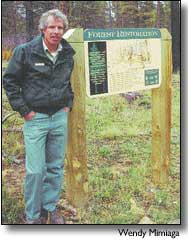|
Oct. 19, 2000 By Janelle Holden
In the wake of one of the worst fire seasons on record, county officials and loggers are hoping that increased political pressure could speed up a local project to thin and treat 133,500 forested acres of ponderosa pine in the San Juan National Forest. Since its founding in 1995, the Ponderosa Pine Forest Partnership, a collaborative effort that has the support of loggers, foresters, and ecologists, has thinned and treated close to 8,000 acres of U.S. Forest Service land northwest of Dolores in danger of catastrophic wildfire and insect infestation. The young trees hand-marked by the U.S. Forest Service for logging have been primarily small in diameter, less than 12 inches, and prone to wildfires and bug infestations. Once the stands are thinned of younger trees, the underbrush is burned by prescribed fire and then ecologically monitored. This project is meant to restore the analyzed acres to pre-European settlement conditions. So far, their efforts to return areas fueled by more than a century of timber overgrowth to smaller stands of older trees has been widely successful. But by anyone’s standards the project is still moving at a snail’s pace. If Forest Service officials agree to move the project from treating 1,000 to 1,200 acres per year to possibly 3,000, the first round of treatments could be completed in approximately 10 years, instead of 20. But Phil Kemp, district forester of the Mancos-Dolores Ranger District, said that moving the project to watershed level would require a complicated Environmental Impact Statement required by the National Environmental Policy Act, and could step up the political stakes for environmentalists worried the Forest Service would allow loggers to cut too many trees. "As you increase the sales, you increase the controversy," said Kemp. "I think if we accelerated analysis and harvest, we might have a 20-year delay in timber harvest," he warned. In addition, the Forest Service would need additional funding and more employees before entering into the complicated process. At the beginning, the project’s harvested timber was priced as if it were saw timber, and marketed for particle board, compost, paper-pulp plants, and other small wood products. Mike Preston, Montezuma County federal-lands coordinator, said that so far the project has stayed economically viable for local logging companies. Since the project began, the opening price for interested bidders on the harvested timber has doubled or even tripled. "The challenge is what do you do with the small and defective material," said Preston. Much of this material has been shipped to the Louisiana-Pacific wafer-board plant in Olathe, one of the few timber mills equipped to work with small-diameter pine. Preston hopes the San Juan National Forest gets a share of increased federal dollars for thinning projects since, in many ways, the project is farther ahead than most. "We’ve been at this for seven years and we’ve made a lot of progress in terms of how you match up the local industry with the opportunity to do forest restoration," he explained. For local loggers to continue a somewhat economically infeasible project, they have to have a steady supply of timber. Many mills have lost the high-stakes gamble in the past by betting the government would sustain a consistent harvest of timber. In 1990, the U.S. Forest Service sold 12 billion board-feet of timber per year, and the number has since dropped to 4 billion. "The key from the standpoint of the local businesses is a predictable supply of wood," agreed Preston. The problem is not the demand. "We’re importing more wood and not cutting and processing as much wood as we have in the past," explained Kemp. The timber industry is capital-intensive, and without promised revenues, American mills have turned to a predictable supply of timber from foreign countries or off of private land. "When you mess with little material like that you have to make huge investments in your infrastructure to make it work." explained Gary Jones, executive director of the Colorado Timber Industry Association in Durango. "Almost all the wood in Colorado is imported from other places. We have a tremendous market potential here to be used, and we’ve studied all the things that can be made out of that wood. It still remains that we just don’t see the confidence in a program on federal lands for a long enough period of time." Few organizations grapple with the same type of trying "Catch-22" requirements as the U.S. Forest Service does. More often than not, bitter arguments between polarized special-interest groups result in a stagnated bureaucratic paper war instead of compromise solutions. "Who wants to beat their head against the wall, fighting against the polarized groups and becoming trapped in the middle?" asked Kemp. "You get tired of wearing the black hat." In this instance, most groups have agreed the partnership was an excellent way to meld interests, but Gary Jones, executive director of the Colorado Timber Industry Association in Durango, warned that the politicizing of timber sales must stop before loggers can be assured of a steady stream of timber, no matter what the size. "I think the polarized wars continue to go on, and until that is resolved the industry is never going to be confidant enough that this is going to go forward on a big enough scale to make it work." |
||||
|
Copyright © 2000 the Cortez Journal.
All rights reserved. |
